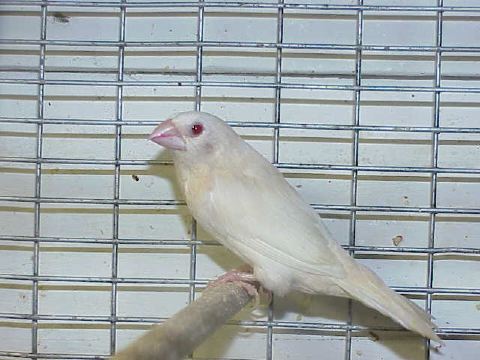

A "Light" Cream Ino Society Hen
The Ino Society is a relatively new mutation in the US. While a few Inos have been in the states for several years, they were in only a few collections, none were ever offered for sale, they essentially remained hidden for years rarely even being seen at shows. Consequently, few people knew of them and they are still rare. (but not much longer! :) The Ino originated in Europe and has been bred there for many years, where it is a favorite with Bengalese breeders.
Description: The Ino is not a color of Society Finch but rather it is a mutation that affects the color of a bird. Inos are often referred to as "Cream" Inos because the best ones exhibit a soft delicate almost pinkish cream/dilute fawn color. Contrary to what many believe, Cream Inos are not at all related to dilute fawns nor any Fawn Society, instead, Cream Inos are in reality Chocolate "Ino" Societies. The Ino factor dilutes the color of chocolate and renders it in a cream form.
Inos that are bred from other colors of Society Finches such as Chestnut or Fawn show and even greater loss of pigment. The bird pictured above is a Chestnut Ino because it only retains a faint amount of cream color on the breast. A Fawn Ino would be completely white and appear as an Albino Society. A true "Cream" Ino (aka chocolate ino) would be cream color all over. (see picture below) Therefore Inos are best bred in a chocolate series to obtain the most and best color possible on an Ino.
Inos also have bright ruby red eyes which adds to their beauty. Visitors to my aviaries who have seen the Inos have consistently remarked at the beauty of "that parctiular 'red eyed' Society", without any knowledge of what they were seeing.
The bright red eye color does not handicap the birds as is the case in some other red eyed strains of Society Finches. Inos are not prone to blindness nor do they show any noteworthy loss of vision. They do exhibit some difficultly seeing in very bright sunlight, but they are quite at home and function completely normally in the breeding room under normal flourscent light conditions.
Genetics: Ino is a sex-linked recessive gene and therefore it is easy to breed.
- Males can be split for Ino
- Hens cannot be split for Ino. Hens either are Ino or they are not, they cannot carry the gene.
- Male Ino X Chocolate hen = Chocolate Males split Ino and Ino hens.
- Ino hen X Chocolate Male = Chocolate Males split Ino and normal Chocolate hens.
Breeding: Its fun to work with a sex linked trait such as the Ino. You can determine the sex of the young immediately. Ino chicks display their bright red eyes as soon as they hatch. My Inos have not presented any problems breeding. Originally I obtain 4 Inos from Japan, 2 males and 2 females and decided to breed them to Chocolate selfs rather than to each other. My goal was to produce as many unrelated split males and Inos hens as I could before mating two Inos or Splits to Inos. The original birds have done very well. In the last 6 months I have produced over 20 Chocolates from the Ino hens and 9 Ino hens from the Ino males. Recently I have paired my first Ino hen to a Chocolate Split male.
It has been suggested by some breeders of Inos that Ino chicks may lag behind in development or even be abandonded, particuarly in large cluthes of young of if there are more dark young than Ino young in the nest. For this reason I have removed some of the Chocolate chicks and fostered them to other Societies, so that the parents would not neglect the Ino chicks. My first observations of Ino and Chocolate chicks in the nest seem to confirm these observations. In a clutch consisting of five young, 2 Inos and 3 Chocolates chicks, the Ino appears to be growing slower than the Chocolates. Perhaps the Inos hatched after the Chocolates, I am not certain. However I chose to remove the Chocolates so that the parents would only have the Ino chicks to raise. In other nests containing fewer chicks of both Inos and Chocolates, no problems were observed and all did well.
Another new color variety that seems to be one of the few that blends well with Cream Ino is the Grey mutation. Grey Inos are pale silvery birds with bright red eyes. I do not believe any are in the US currently but I have Grey Societies now and perhaps once my Inos are well established I will attempt making a Grey Ino combination.
Ino Societies will be a great addition to the US Society scene. They are very attractive and appear easy to breed.
Below are a couple of picts from my friend Jim.
- "Grey" Ino bred by Jim Warburton of England
- "Cream" Ino bred by Jim Warburton of England
- Society Finch Price list!
Pieds | Selfs | Dilutes | Clearwings | Pearls